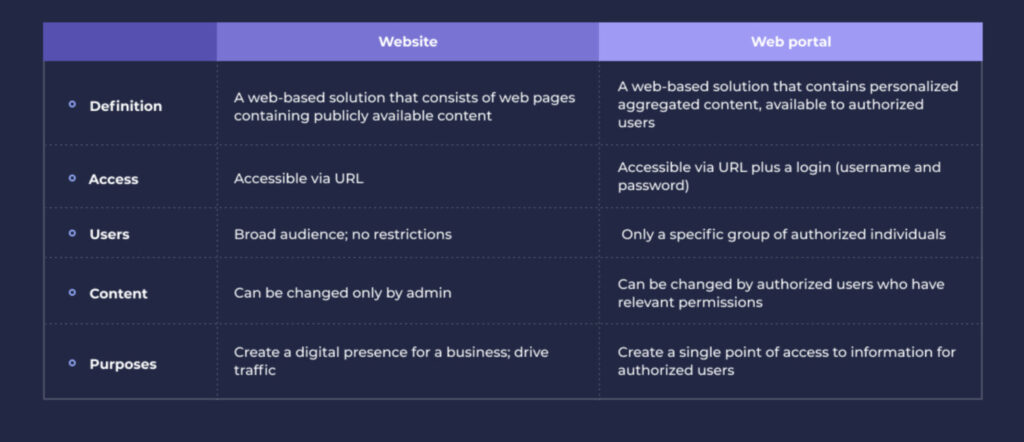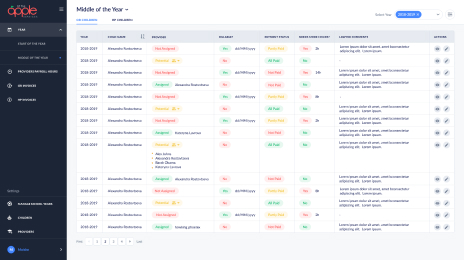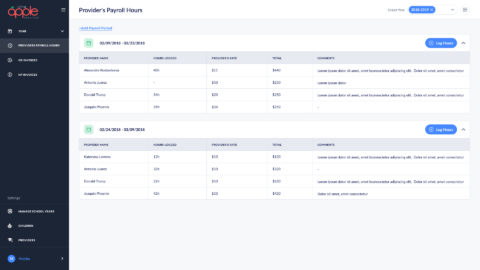Table of Contents
Web solutions have become very common among various businesses. One can hardly find a company that won’t benefit from having a web portal. This type of software allows organizations to automate numerous processes and significantly increase employee, customer, and partner engagement with the business. But how much money does a company need to develop a handy web portal that will satisfy its needs? And what factors will influence the price?
In this article, we’ll try to answer all these questions and provide you with some basic info about web portals, their types, and functionality. Perhaps more importantly, we will explain what differentiates web portals from websites because people still think that these are just two different names for the same thing.
What is web portal development?
To begin with, let’s give a definition of a web portal. Basically a web portal is a single access point to various kinds of information provided by a company. That information can be categorized and accessed by certain links. For example, a web portal will let you access company articles, information related to products, or even vendors or suppliers lists.
However, to access that information, you need to perform one crucial step—create an account or log in using your email and password. Web portal users can access various information provided by web portal owners. That information can be pulled from various sources and located conveniently in one place, making web portals very convenient and user-friendly. You can also communicate with other web portal users besides accessing information.
Key differences between Web Portal and Website
When it comes to custom development of web solutions, many confuse a web portal vs website because they have some basic features. In particular, both are the internet solutions accessible via a unique web address (i.e. URL). Yet, these web products serve different purposes, have their distinctive characteristics, and are not interchangeable.
Therefore, we have prepared a comparison table so you can understand what defines each of those web solutions. Let’s take a closer look at it to clear everything up.

To sum up, a website is a platform that helps a business digitally present itself to the world and convey messages to everyone interested in its products or services. It doesn’t involve active participation from the users but aims to highlight brand uniqueness and raise awareness of it.
Web portals have a narrower focus, as their main goal is to provide particular people with specific information. Their content changes based on user input. While websites can offer static and dynamic content, web portals work only with dynamic content and always require authorization from the user side. Now that you know all the key differences between web portals and websites, it is high time to examine the first one in detail.
New Trend
These days, a new kind of solution has become extremely popular among business owners. We are referring to advanced internal web-based portals, also known as omni-portals. This is like a huge unified technology centre that helps companies manage content, clients, various collaborations, knowledge, save work templates, etc. To find out more information about omni-portals, check out this article.
Common types of business web portals
As we’ve already mentioned, web portal development helps businesses create a personalized experience, share documents, and streamline communication & processes. Since every company needs to operate effectively, web portals may be used in numerous ways. In general, there are two main types of web portals.
Horizontal web portals
They are often used by several companies. They are like their common platform, which aims to provide all crucial information that users might need to know while searching for external services. Examples of horizontal web portals would be educational, governmental, and cultural ones.
Vertical web portals
They are also known as vortals. Companies use such web portals to provide users with specific information related to their services. Companies can share something really specific that cannot be provided on a usual website. Examples of such portals are college and bidding ones.
And now, let’s speak about more specific web portals that are oriented and geared towards specific purposes and have different target audiences.
Customer portal
By developing a customer portal, an organization can not only take its customer support and sales process to the next level, but also gets a chance to improve brand loyalty. Users of such a portal have an opportunity to place and track orders themselves, report problems, activate or deactivate services, get personalized recommendations, review the purchase history, and do many other things without the need to contact the company’s customer service reps. This saves their time, increases satisfaction, and helps to build long-term relationships.
B2C customer portal
A B2C customer portal is a must-have tool if you are selling goods or services. Not only does it help drive sales by offering better customer service and helps companies establish long-lasting and loyal relationships that turn into partnerships with their customers. Several features should definitely be present in your B2C portal: account creation and editing, intuitive and yet advanced order placement, tools for checking and managing the orders, several payment methods so that every customer can conveniently and successfully complete the purchase, personal recommendations of goods or services, reporting tools.
B2B customer portal
These days, companies that offer the same goods or services are finding themselves to be fighting for customers. That is why having a competitive advantage like a B2B customer portal is so crucial. This product can help companies to offer well-organized customer self-service (meaning that personal touch and automation will be balanced), perform better post-order management, offer information to customers 24/7 and create a personalized approach to each customer, offer flexible and convenient payment options, implement advanced order management tools.
Employee portal
Building an employee portal should be one of the first steps for companies going through digital transformation. It’s like an internal social network where users can communicate, assign tasks, update each other on important events, leave comments, log timesheets, request vacations, etc. On top of that, employee portals make it easier for new hires to overcome onboarding chaos and help them become a part of the team more seamlessly. As a result, people collaborate more effectively and stay more engaged.
Partner portal
Companies do not exist in isolation, and they need to cooperate with many other businesses regularly. This especially applies to real estate, travel industry, banking, healthcare, and logistics. To conduct their activity successfully, organizations from these business niches need to ensure an ongoing process of information exchange, two-way communication, and constant involvement of all parties engaged. A partner portal is a great tool to make interactions with other businesses reliable, effective, and results-oriented.
Vendor portal
This type of portal is perfect for companies that can use a powerful communication and data exchange platform with many vendors. Vendor management is crucial but time-consuming, so vendor portals are created to encourage self-service, reduce employee overload, and even save some costs. Vendor portals also make department cooperation easier and more effective, since your employees can collect all vendor information in one place and use it when needed.
Membership management portal
This type of web portal will be helpful for any business that offers membership subscriptions, for example, learning platforms. Besides obvious benefits like self-service, such portals allow for greater accuracy of members’ data at any given point in time since users can update it whenever some of their personal information changes. In addition, the management of the customer base becomes almost entirely automated. Members receive all materials, build training or any other plans for using a service, monitor the progress, payments, etc. with little to no manual administration efforts from your side.
Web portals that are gaining popularity in 2025
Last year, the pandemic brought about many changes and challenges. So many business industries have had to rethink their strategies, approaches, and even digital tools used daily.
In a world where society was significantly constrained by virus outbreaks and people for various reasons found themselves stuck in their homes, limited and changed a lot of people’s daily lives: working, studying, and training from home was widely popularized.
But it is hard to stay productive without reliable solutions. Therefore, the need for developing new web portals is a no-brainer. We have analyzed the market and searched for new web portals that appeared. In the end, we discovered that three key types of web portals are in demand now. Let’s take a closer look at them.
Community portal
This type of web portal is created for groups of people who share the same interests and would like to build a network to share their experiences, ideas or some specific matters. A community portal is a special place where people from different parts of the country or city can effectively interact and create specific interest-related content. The community portal should definitely include a blog, forum, admin panel, media files support, and convenient communication tools like built-in messenger. With the outbreak of the pandemic, people tend to use community portals more often since they help them feel less isolated.
E-learning portal
Needless to say, e-learning is not only a huge trend right now, but it is also a necessity that appeared due to lockdowns and the inability of students to attend colleges and universities in person. We all know how many e-learning apps you can find on the market, but what about web portals? They are way more convenient and do not require downloading. E-learning portals can provide access to various study materials like video lectures, e-books and guides, presentations, interactive materials and more. Such portals can be used not only by students but also by corporations to train their employees.
Good to know
Our experts have previously covered the topic about enterprise web portals that are used by companies of different sizes. Such solutions help establish effective communication between different internal departments within a company, and achieve better management and information distribution. If you are interested in hearing about all the advantages of enterprise web portals and their website development, then read this post.
Key benefits of web portal development
It doesn’t really matter for what business industry you are building a web portal since, after all, they all have the same key benefits that you should know of.
How to build a web portal
Let’s say you’ve made the decision to start web portal development for your business. The first thing you should know about the development process is that it is going to be quite difficult, rather time-consuming and costly. People who are not related to the technical sphere often think that development consists of 2 main steps – web portal building and the creation of its design. But in fact, it is way more complicated than that.
The development consists of numerous stages and steps, and each one of them is crucial and indispensable. So we have prepared information that will help you understand the web portal development lifecycle better. And, without further ado, let’s check all the steps immediately!
#1 Preparations
Some people from the business sphere neglect this step because they prefer not to waste their time on collecting the data. They are eager to write specifications and start the development as soon as possible. But this is a huge mistake that can lead to budget holes and unforeseen risks.
The discovery phase is crucial for every project and especially for such complicated ones as web portals. Preparations should include the following steps:
Everything begins with the right question: “Who will use your web portal?” The answer to this question will help you identify your target audience, their key needs and pains and decide what kind of portal you need to develop. The discovery stage will also help you identify the major feature set and tech stack used.
PRO ADVICE
Preparation or as we call it “Discovery Phase” is crucial and you should not skip it. We have already described the importance of the preparation and the deliverables you can get after it ends. So we’d recommend you to take a minute and read that post.
#2 Planning
After the discovery stage is over, you will get a thorough report from a Business Analyst and a draft of initial project specifications. You will also be aware of the technology stack that will be used for your projects, the risks that can possibly appear, the development time and the approximate project cost. With all that information in hand, you can begin planning the development of your web portal. In this stage, it is crucial to divide big tasks into smaller ones, set deadlines, identify the scope of work for each stage, and build more or less accurate work schedules.
#3 Design
The architecture of the web portal comes before the design; once it is ready, your team can create a look for your solution. Architecture can be created in the form of a sitemap describing the hierarchy of all pages in your web portal. It is also crucial to define the connections between those pages and then consider their look.
When making your web portal visually appealing, you should always keep your target audience in mind (and the type of web portal you want to create should also be considered). The selection of colors, icons, and other elements will depend on this. For example, the partner portal should be more strict, without bright colours and hideous elements, keeping it simple, professional, and organized. The portal for employees can be less rigid in style.
Once you and your designer reach a compromise, it is time to start prototyping. As a result, you will be able to take a glance at a preview of how your future web portal will look like and make the necessary alterations and modifications if needed. Do not be mistaken; the design is no less important than the functionality of your web portal.
Related Topic
Some people think that web design and web development imply the same processes. However, it is not so. We would recommend you to check out the article on our blog dedicated to differences between web design and development, to make sure you are on the same page with your team.
#4 Development
To begin the development stage, you need a prototype and site map of your web portal. With these things in hand, your developers team can start coding and turning your idea into a real-life solution. The main goal of this stage is to get a product that looks, functions and feels exactly as you wanted and envisioned it to.
The first thing that will be developed is your web portal’s home page. Then, the team will proceed to create all of the other necessary and all-important sections, buttons and other elements of your portal.
At Altamira, we have developed several successful web portals for our clients’ businesses. So speaking about the web portal development part, we’d like to name some technologies that are going to be used:
- Development from scratch will be performed using PHP;
- CMS-powered solutions can be built on WordPress or Salesforce.
As to the team that will enable you to turn your idea into reality, it should include the following specialists.
#5 Testing and Release
Testing is a crucial part of any project development since it helps to discover all errors, weaknesses and other bottlenecks of the solution and to fix them right away. So rest assured that your web portal will be thoroughly checked and tested before being released. The portal performance, navigation, registration and creation of an account – all these and many other features will be tested. The goal of the testing is to make sure that everything functions fine and that the user experience is on the highest level.
It is also important to check the compatibility of your solution with different browsers. SEO and plugin installation (if you have a CMS-powered web portal) are also a must. Testers will check whether all plugins work correctly, and whether your web portal is attractive to search engines (SEO-optimized). Once everything is tested, works as it is supposed to and is in order – you can launch your solution.
#6 Maintenance
Some business owners consider that once they get a perfect solution for their company, there is no need to invest in it further. After all, it works just fine, and it can feel as though it can and will feel this way indefinitely or at least last for years into the future. However, the reality is that you need to improve your web portal and perform functionality checks constantly. For instance, some plugins may stop working correctly with time. Or they will no longer be compatible and cause some functional issues.
Also web portals should offer high levels of usability and engagement, that is why it is necessary to turbocharge it with high level functionality, and not pass up on opportunities to add something new and exciting. Based on our experience, we can say with confidence that maintenance is no less important than the web portal development itself.
Web portal development services we offer
Altamira team has vast experience in building various web portals for different purposes and target audiences. All our clients can benefit from 2 key types of services that we offer.
Consulting services
including marketing research, market competition research, thorough planning, selection of feature set and tech stack, writing of technical documentation (software requirements and specifications) and prototyping of your web portal.
Full cycle development
we perform web portal development for a desired platform, integrate all required third-party services, help you with mastering a new solution, its launch and provide further improvements, continuous support.
Our experience and approach to web portal development
Altamira is a highly experienced web portal development company that believes that examples speak louder than words. Therefore we’d like to mention a couple of great web portals we’ve worked on. One of them was for aircraft brokerage business and the second one – for the company that provides services for deaf or hearing impaired children (speaking of starting a company with a noble cause). Both companies had some productivity issues. Their employees were overloaded with tasks, the order and requests management was quite complicated.
Both businesses needed a digital optimization to boost productivity and client services function, and to improve communication and cooperation between their employees. So we’ve developed functional web portals powered by the best technologies that were available for carrying out those particular projects.
The solutions we’ve released work like a charm and we’ve only received positive feedback from business owners who entrusted us with the development of their web portals. To provide you with some real examples of web portal functionality, we’ve prepared a couple of screenshots of one of our projects.

As you can see from the example, the web portal has advanced functionality. Not only can a person register, manage an account and get information about necessary services and payments, but also it is possible to manage invoices, school years, children lists and much more.
There are a variety of options that can be collected in one solution to make the service offerings more transparent, organized and convenient. Every necessary detail is right at the users’ fingertips. A couple of mouse clicks and you get all of the information.

Now as to our approach to web portal development, we deliver not only high-quality products, but we also think of their integration into the working environment of our clients. So let’s say our client already uses CRM or ERP, we have to make sure that the web portal can be successfully connected to them and transfer or receive all crucial data.
We also pay special attention to APIs since they can make a web portal even more functional. Among all web portal development services we provide, security and convenience of the end product are always our key priority. We always make sure that the web portal is easy to use, its functions are intuitive and useful and design corresponds not only to all of the latest trends but also to the needs and requirements of a company we work with.
The real web portal development cost
If you decide to work with a web portal development company from Ukraine, the custom web portal development cost on average will range of $30,000-$80,000. Of course, there is no ceiling to the cost and the final price may be much higher if, for example, you want to build a very complex solution with many user groups having different rights and permissions.
For your better understanding of the web portal development price and the amount of time that can be spent on its development, we have prepared a table. This table is relevant for the MVP (Minimum Viable Product) of a custom web portal development, so the price of a full solution can be higher as well as the total development time.
| Dev stages | Dev hours | Total cost |
| Specifications | 30 | $960 |
| Design | 25 | $975 |
| HTML/CSS | 36 | $900 |
| PHP Development 4 | 425 | $11475 |
| PHP Development 6 | 128 | $5248 |
| Testing | 178 | $3026 |
| Admin | 29 | $638 |
| SM | 81 | $1863 |
When choosing the type of contract, opt for time & materials rather than a fixed-price agreement. Web portal development usually takes some time and your requirements may change so it’s a wise decision to stay flexible in terms of the scope and budget.
Factors that influence web portal development price
Like with building any other bespoke software solution, there is no fixed web portal development cost. Many aspects may impact the budget that is required for a project. So let’s take a look at the most significant of them.
Functionality

It’s up to you to decide what functionality to include in your web portal. But, naturally, the more complex you want it to be the more money you’ll need. Here are the most popular features of web portals:
In addition, it’s important to ensure a system integration with third-party solutions as well as make a web portal powerful, maintainable, and scalable.
Outsourcing Company vs Freelancers
It’s another choice you’ll have to make at the very beginning. As a rule, freelancers charge less but there are a lot of risks associated with this type of cooperation model. For instance, independent programmers frequently fail to meet deadlines or can quit the project in the middle of the road. So a low price oftentimes ends up coming at a high cost. That’s why it’s better to entrust and delegate web portal development to a reliable IT outsourcing partner.
Developers' seniority levels
Senior engineers have higher hourly rates than do their junior colleagues, but the latter ones usually work more slowly/less effectively. Ideally, you would have a coding team composed of programmers of different levels of seniority. If you envisioned a complex and long-term project, hiring a dedicated team might be the best option.
Programmers' geographic location
It’s not a secret that developers’ rates differ depending on the region of the world. Programmers from the US are believed to be the most expensive, charging about $100-200 per hour while engineers that are located in Asia may cost you just $15-40 an hour. However, developers from Asia have a reputation for delivering lower-quality products. So it’s better to choose Eastern European programmers who offer a supreme price/quality ratio with hourly rates ranging from $25 to $40.
To wrap it up
Today’s business world is driven by technologies, so web portal development is a must for any company that wants to stay competitive. In general, portals can be used in many areas of an organization, for instance, customer support, business partnerships, or internal collaboration.
The exact costs you’ll need for the project will depend on numerous factors such as the development method you will choose, product complexity, developers’ seniority levels, as well as their geographic location. Our recommendation is to choose a coding team from Ukraine to get superior quality for a reasonable price.






